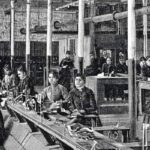We explain what the consumer society is and its main characteristics. Also, some examples, causes and consequences.

What is the consumer society?
“Consumer society” is a concept that began to be used after the end of the Second World War (1939-945) to refer to the consumption-oriented lifestyle typical of Western societies.
Societies throughout their history have always consumed in one way or another. When talking about the consumer society, reference is made to the way to acquire goods that have been mass produced (that is: in large quantities and at low cost). Thus, for companies, their focus is no longer on manufacturing, but on how to sell the products they have manufactured.
This forces firms to resort to a series of tools (such as marketing and advertising) to place these goods on the market. Thus, the acquisition of necessary goods and others that are not necessary begins to be encouraged.
Within these societies, it is impossible not to talk about “consumerism.” This is: excessive and unnecessary consumption of goods and services.
See also: Utility
Characteristics of the consumer society

In consumer societies There is a huge variety of goods and services that not only are they produced to a greater extent than what is demanded (due to the low costs that mass production represents) but, at the same time, these are goods that are not always necessary for people's lives.
This way, companies manage, through marketing and advertisingto create needs artificially, which they then offer to satisfy through their products.
These societies are characterized by an enormous amount of goods – and increasingly more services, especially with the emergence of the Internet – and a large number of brands that produce them. Thus, they must manage to highlight what their differentials are, even if these are practically zero. This is where, once again, advertising and marketing are decisive.
Planned obsolescence is a determining concept in consumer societies. What does it consist of? In the manufacturing products that deliberately have a useful life: They are manufactured in advance with a certain durability so that their owner is forced to discard it and buy a new one.
Obviously, the companies that manufacture their products under this slogan manage to make the consumer consider that the relationship between price and quality is convenient, in order to choose that brand again and not turn to the competition.
Planned obsolescence is a way to keep the consumer society going. The thing is that, without it, it is likely that the manufacturers of a certain product (such as a cell phone) will have many sales as soon as they launch it. But, as time goes by, those sales will fall until they become zero, complicating the company's existence.
So what does that cell phone company do? Beforehand, it manufactures a device knowing that, in a short time, its user will find it old or outdated because it does not have certain functions, it does not allow certain applications to be downloaded, or whatever. At the same time, the user will buy another “updated” model again. or surpassing, despite the fact that the previous one did not break but continues to work. It simply became “old.”
Also, it may turn out that the purchased good breaks or damages and its owner will find it more expensive to repair it than to purchase a new one. So, you throw away the product you have and buy a new one.
Planned obsolescence can also be due to “fads”. The person does not buy new pants because the one they had broke or no longer fits, but simply because they became out of fashion and the market launched new models that no longer look like the one from the previous season.
Examples of consumer societies
Within consumer societies, certain practices can be observed that differentiate them from other types of societies. Some examples that allow them to be identified are:
- People consume goods and services in order to satisfy superfluous or artificially created needs.
- Companies make low-quality products so they are quickly discarded and replaced.
- Economic success is at the top of the scale of values.
- Consumers use different forms of financing, such as paying in installments with a credit card, to spend beyond their income.
- Consumers are predisposed to constantly use and throw away products.
- People's identity is built based on what they consume.
- The brand becomes an indicator of the social status to which its consumer belongs or aspires to belong.
Causes and consequences of the consumer society

Some of the causes that induce people to buy and thus support this type of companies are:
- Fashion. The tastes shared at a time and place by a group of people push consumers to purchase goods that suit them, regardless of whether the person truly needs that good.
- Advertising. The strategies promoted by companies to create superfluous needs are usually an important driver of consumption.
- Financing. The fact that there are different ways to obtain goods, without having money at that time, encourages consumption.
Some of the consequences that societies that gain meaning from consumption can generate are the following:
- Pollution. Consuming, throwing away and repurchasing, even when the product continues to serve, generates enormous volumes of waste. But industries, which manufacture constantly and in large quantities, can also generate waste and gases that endanger the environment. The enormous amount of raw materials used to sustain manufacturing volumes and the speed at which those materials are used also have a significant environmental impact.
- Obesity. Advertising also invites you to consume food. Many of them are low quality, very cheap and unhealthy.
References
- “The consumer society: origin and characteristics” in Eumed.
- “Programmed obsolescence” in the Technology Area.
- “The consumer society: to live is to consume” in The World Order.





